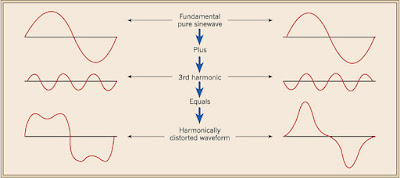Harmonic voltages and currents in a Power System are a result of non-linear electric loads. In a normal AC Power System, the current varies sinusoidally at a specific frequency, usually 50 or 60 Hertz. When a linear electrical load is connected to the system, it draws a sinusoidal current at the same frequency as the voltage, though usually not in phase with the voltage.
Further examples of non-linear loads include common office equipment such as computers and printers, Fluorescent lighting, battery chargers, electronic ballasts, variable frequency drives, and switching mode power supplies.
Total Harmonic Distortion or THD is a common measurement of the level of harmonic distortion present in power systems. THD is defined as the ratio of total harmonics to the value at fundamental frequency.
where Vn is the RMS voltage of nth harmonic and n = 1 is the fundamental frequency.
Effects of Harmonics:
One of the major effects of power system harmonics is to increase the current in the system. This is particularly the case for the third harmonic, which causes a sharp increase in the zero sequence current, and therefore increases the current in the neutral conductor.
Electric motors experience losses due to hysteresis and losses due to eddy currents set up in the iron core of the motor. These are proportional to the frequency of the current. Since the harmonics are at higher frequencies, they produce higher core losses in a motor than the power frequency would. This results in increased heating of the motor core, which (if excessive) can shorten the life of the motor.
The 5th harmonic causes a Counter Electromotive Force in large motors which acts in the opposite direction of rotation. The Counter Electromotive Force is not large enough to counteract the rotation; however it does play a small role in the resulting rotating speed of the motor.
Thank you!


PREGUNTA EN UNA RESIDENCIA DE 5000 WATTS SERIA NORMAL CONTAR CON UNA TERCERA ARMONICA
Dear sir,
what are the advantages of harmonics in power system.